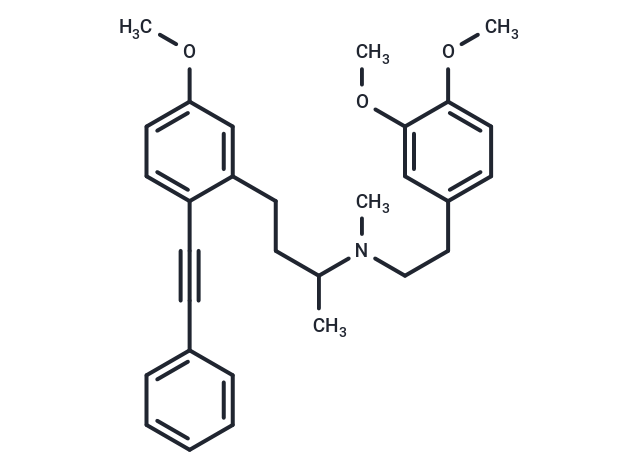
McN5691
CAS No. 99254-95-2
McN5691( —— )
Catalog No. M33013 CAS No. 99254-95-2
McN5691 (RWJ26240) is a voltage-dependent calcium channel blocker with antihypertensive activity that can be used in the study of diseases caused by vascular smooth muscle abnormalities.
Purity : >98% (HPLC)
 COA
COA
 Datasheet
Datasheet
 HNMR
HNMR
 HPLC
HPLC
 MSDS
MSDS
 Handing Instructions
Handing Instructions
| Size | Price / USD | Stock | Quantity |
| 2MG | 445 | Get Quote |


|
| 5MG | 686 | Get Quote |


|
| 10MG | 938 | Get Quote |


|
| 25MG | 1398 | Get Quote |


|
| 50MG | 1822 | Get Quote |


|
| 500MG | Get Quote | Get Quote |


|
| 1G | Get Quote | Get Quote |


|
Biological Information
-
Product NameMcN5691
-
NoteResearch use only, not for human use.
-
Brief DescriptionMcN5691 (RWJ26240) is a voltage-dependent calcium channel blocker with antihypertensive activity that can be used in the study of diseases caused by vascular smooth muscle abnormalities.
-
DescriptionMcN5691 is a voltage-sensitive calcium channel blocker.
-
In VitroMcN5691 (1 and 10 μM) prevents 60 mM KCl-induced contraction and calcium uptake and causes concentration-dependent relaxation (EC50=190 μM) of 30 mM KCl-contracted aortic rings. At or below 10 μM, McN5691 (McN-5691) has no effects on basal tone or calcium uptake (45Ca) in isolated rings of rabbit thoracic aorta. McN5691 causes complete high affinity inhibition (Kd=39.5 nM) of specific diltiazem binding to the benzothiazepine receptor on the voltage-sensitive calcium channel in skeletal muscle microsomal membranes. In contrast to diltiazem, McN5691 inhibits specific dihydropyridine receptor binding, but the effect is biphasic with high (Kd=4.7 nM) and low (Kd=919.8 nM) affinity components. McN5691 inhibits norepinephrine (NE)-induced contraction (10 μM) and calcium uptake (1 and 10 μM) and causes concentration-dependent relaxation (EC50=159 μM) of 1 μM NE-contracted rings of rabbit thoracic aorta.
-
In VivoThe excretion and metabolism of a 2-ethynylbenzenealkanamine analog, antihypertensive McN5691 (RWJ-26240), in beagle dogs is investigated. A total of 96.8% and 2.8% of the radioactive dose are excreted in feces and urine, respectively, during the 7 days after oral administration of 14C-McN5691. Of the radioactive dose, 96.8% and 2.8% is recovered in feces and urine, respectively, in the 7 days after oral administration of 14C-McN5691. More than 87% of the dose is excreted in feces during the 48 hours. McN5691 is extensively metabolized in dogs. Unchanged McN5691 is found in less than 0.1% and 19% of the dose in the 0-24 hour urine and 0-48 hour fecal extract, respectively, and 36% of the sample in the 4 hour plasma. In the McN5691 (McN-5691) study, vascular resistances tend to be higher in spontaneously hypertensive rat (SHR) than in Wistar-Kyoto (WKY) but the differences are statistically significant only in the cerebellum and the midbrain.
-
Synonyms——
-
PathwayGPCR/G Protein
-
TargetCalcium Channel
-
RecptorCalcium Channel
-
Research Area——
-
Indication——
Chemical Information
-
CAS Number99254-95-2
-
Formula Weight457.6
-
Molecular FormulaC30H35NO3
-
Purity>98% (HPLC)
-
Solubility——
-
SMILESC(#CC1=CC=C(OC)C=C1CCC(N(C)CCC2=CC=C(OC)C(OC)=C2)C)C=3C=CC=CC3
-
Chemical Name——
Shipping & Storage Information
-
Storage(-20℃)
-
ShippingWith Ice Pack
-
Stability≥ 2 years
Reference
1. Flaim SF, et al. Structurally novel antihypertensive compound, McN-5691, is a calcium channel blocker in vascular smooth muscle. J Pharmacol Exp Ther. 1991 Jan;256(1):279-88.?
molnova catalog



related products
-
Lercanidipine
Lercanidipine is a calcium channel blocker of the dihydropyridine class.
-
1,2,4-Trihydroxybenz...
1,2,4-Trihydroxybenzene (Benzene-1,2,4-triol) is a by-product of coffee bean roasting and is found in mouse, arabica coffee.1,2,4-Trihydroxybenzene is a benzotriol that increases Ca2+ concentration in rat thymic lymphocytes.
-
Ziconotide Acetate
Ziconotide is an analgesic agent and has been used to treat neuropathic and non-neuropathic pain. Ziconotide acts by binding to N-type calcium channels situated on the terminal part of primary afferent neurons of the nociceptive pathway therefore reducing synaptic transmission with potent antinociceptive effects.



 Cart
Cart
 sales@molnova.com
sales@molnova.com


